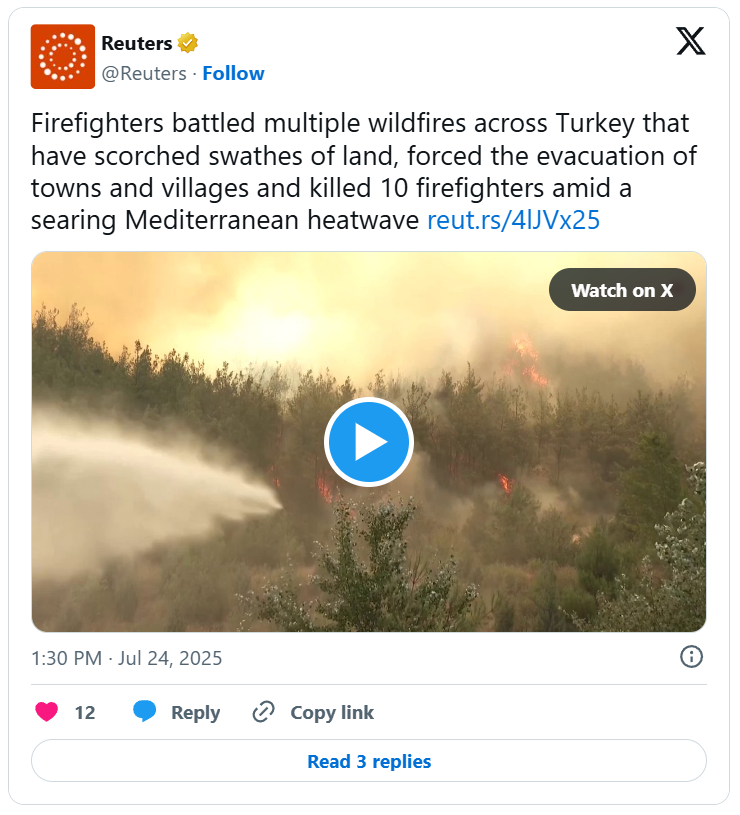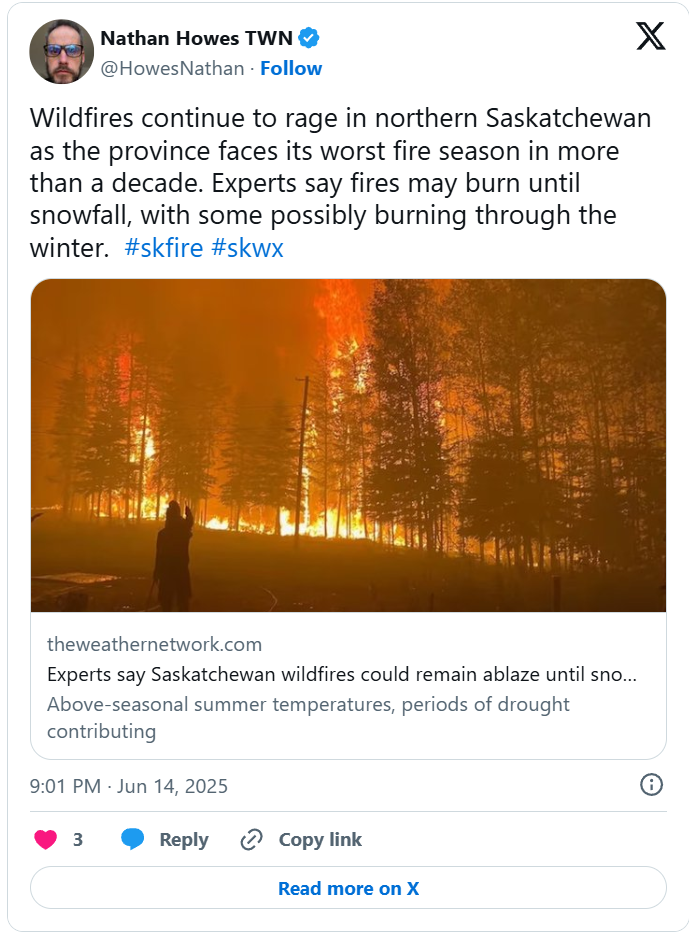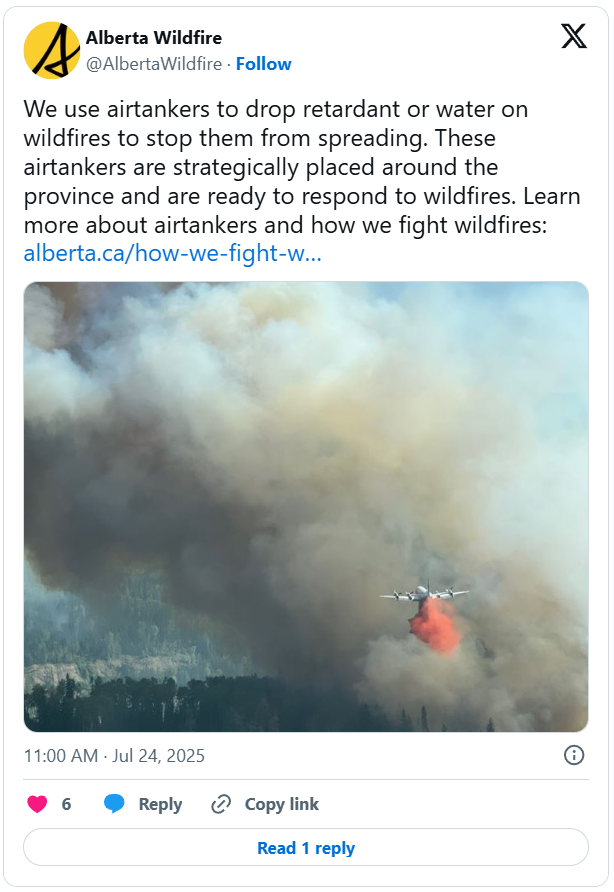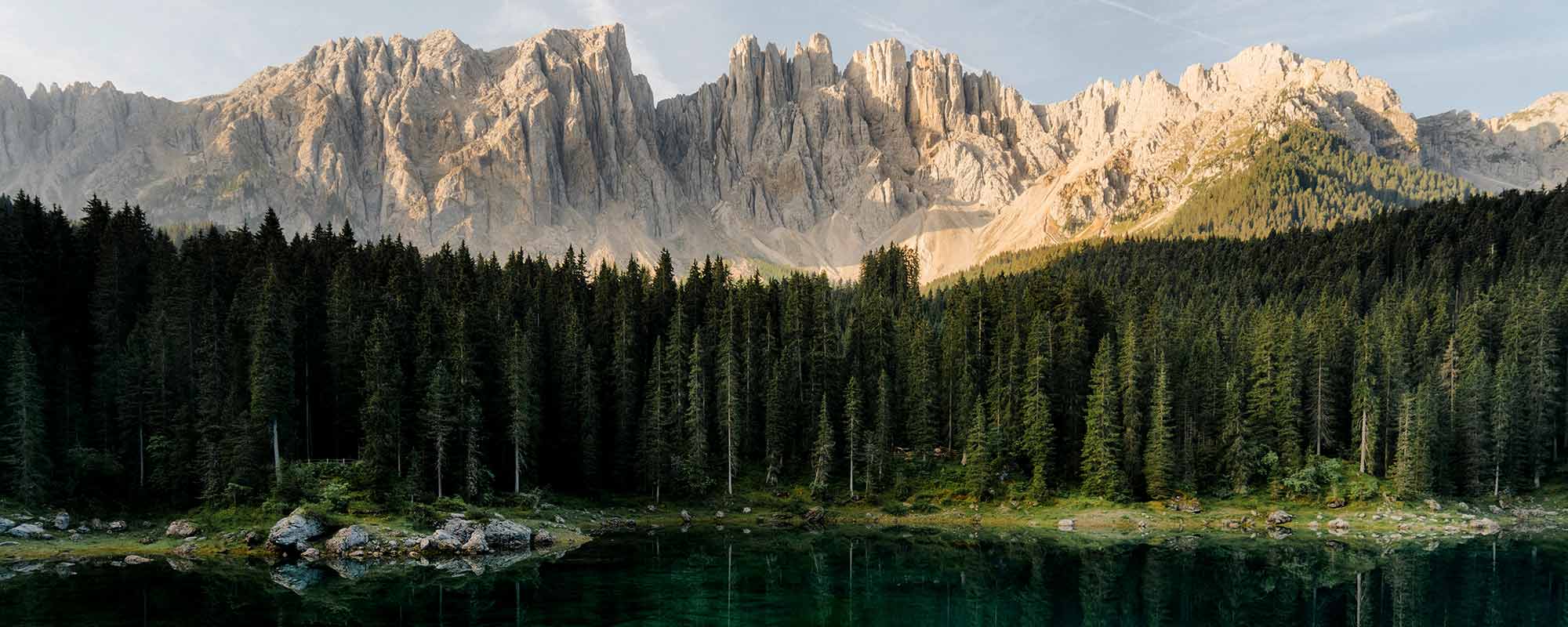As originally published on Morningstar.com.
For people watching the wildfire season closely, there’s a very good chance that we’ll have another very bad summer. Factors like increased heat, decreased humidity, effects to vegetation, and changing wind patterns are making wildfires a more regular occurrence. Fires are currently scorching Cyprus and Turkey. In Canada, home to one of Morningstar Sustainalytics’—a division that provides sustainability research—main offices, wildfire damage has already surpassed that of 2024. Even far from the fires, public health risks from smoke are rising. And it’s only July. The sheer scale of its predominantly coniferous forests makes Canada “much more flammable,” says Luke Raftis, environmental, social, and governance research lead for global utilities for Sustainalytics.

From a purely humanitarian standpoint, it’s a scary prospect. It also creates challenges for regional economies, global markets, and investors. I checked in with Luke and with Toshi Batbuyan, ESG research lead for energy companies, about what wildfires mean for the industries they cover and the risks for investors. There are opportunities, too. Indeed, Toshi says, companies that can maintain operations through a wildfire crisis, when peers can’t, have a powerful competitive advantage—a key ingredient for what Morningstar calls a moat. To learn what Luke and Toshi said, keep reading.
Ron Bundy: Let’s start with the big picture. Tell us about Canada’s experience with wildfires in recent years. Is it a good proxy for wildfires globally?
Luke Raftis: Wildfires have been a part of the boreal forest ecosystem forever, but there’s been a fundamental change in the last few years. The year 2023 was record-breaking in Canada, with over 12-million hectares burned, more than double the previous worst year. That’s roughly the same size as Pennsylvania or Bulgaria. In mid-July, we’re already up to the 2024 level, which was the second worst on record.
The scientific consensus is that this is primarily caused by climate change, and it’s in line with what we’ve seen elsewhere in the world, and what we’d expect from the models. Higher latitudes are warming a lot faster than the global average, about 2 times faster for Canada overall, but even more so in the Arctic, which is where some fires are taking place now.

California and Southern Europe were experiencing increased wildfires at a much higher level decades earlier. Now the trend is worsening almost everywhere, including places that historically didn’t have serious wildfires such as the Pacific Northwest, Colorado, or New York. Canada isn’t unique but stands out because of the sheer scale of its forests and fires. Canada’s forests are predominantly coniferous, and thus much more flammable.
Wildfires Matter for Utilities and Energy Stocks
Bundy: Why are wildfires relevant to utility and energy companies globally?
Raftis: For utilities, it’s important to distinguish whether the transmission equipment was responsible for igniting the fire, say because of a faulty power line or was just damaged by a fire started by something else. While the damage can cause major outages and repair costs either way, liabilities associated with igniting a fire can be massive, because fires often result in major property damage and fatalities and then corresponding class action lawsuits, penalties, etc. Several multibillion-dollar fires in recent years were associated with utilities and many exceeded any insurance coverage. California has specific legislation that makes utilities liable even if they follow all the rules, but even in other jurisdictions, being responsible for a fire can result in major liabilities.
Toshi Batbuyan: For the oil and gas sector, the risk is equally material but manifests more as a direct physical threat. Wildfires don’t just threaten to damage expensive centralized facilities. They also force immediate production shutdowns that have a direct impact on revenue. There’s a tangible threat of fire halting operations and potentially destroying billions of dollars in capital-intensive assets.
Bundy: Why are utility and energy companies more vulnerable to natural disasters like wildfires, which are becoming more frequent with climate change?
Raftis: Utility grid networks stretch for thousands of kilometers through all sorts of terrain. The equipment is vulnerable to fires but also has the potential to start them. The main factors that result in wildfire ignition for utilities are extremely dry, windy conditions in an area with lots of vegetation and also medium- and low-voltage lines. These lines are the most problematic as they’re typically lower, closer to tree height, and aren’t cleared as far back. That suggests a higher probability that an energized line encounters vegetation. Once vegetation becomes sufficiently dry, though, everything becomes flammable, and the risk escalates enormously.
Batbuyan: In oil and gas, vulnerability comes down to geography. Major assets, like the Alberta oil sands or Western US gas fields, are often highly concentrated in remote fire-prone landscapes. This creates the potential for so-called Natech events, where a natural hazard triggers a technological accident like a spill or explosion. This vulnerability extends across the entire value chain from the production wells right through the pipeline networks that carry the product.
The Biggest Wildfire Risks
Bundy: Let’s have some specific examples.
Raftis: Climate change has very different impacts in different regions. Areas with prolonged droughts and high summer winds, such as California and Portugal, are clear examples for high fire-ignition risk for utilities. Having a lot of forest cover near transmission lines is another major factor. But in very dry regions, even downed wires can easily ignite, as exemplified by the 2023 Hawaii wildfires. The fire risk is increasing in many regions, including most of North America, South America, and Southern Europe.
So far, the greatest liabilities have been in the US with PG&E PCG, Edison International EIX, Sempra SRE, Xcel Energy XEL, Berkshire Hathaway BRKA, and Hawaiian Electric Industries HE. Canada hasn’t seen many confirmed cases of ignition. This is just a matter of time, as the climate gets drier. Most of the fires ongoing right now were started by lightning or accidental human causes.
Batbuyan: The risks are global. One is production risk. In Canada, the May 2025 wildfires forced major players like Suncor Energy SU or Cenovus Energy CVE, to shut down production of hundreds of thousands of barrels per day. Another is infrastructure risk: a TC Energy TRP pipeline ruptured and started a wildfire in 2024, showing that pipelines can be both victims and ignition sources. This isn’t just a Canadian problem. In Siberia, for example, intense fires are accelerating permafrost melting, threatening the stability of the massive infrastructure built on it. The 2020 Norilsk Nickel GMKN diesel spill is a perfect example of this kind of ground-failure risk. And in South America, companies are bidding on exploration blocks near the Amazon, placing new, high-value assets in the path of fires driven by deforestation.
Bundy: Who’s doing a good job addressing these risks effectively?
Raftis: Ironically, some companies now leading best practice previously suffered the biggest disasters. For example, California got drier and hotter starting from the south over the years. Sempra, parent of San Diego Gas & Electric, was among the first to face this escalated risk. They’ve improved risk management and introduced technical innovations, including changing the transmission line settings, situational awareness including real-time monitoring of everything, more weather stations, and grid hardening. Those practices are being rolled out to other places now facing such risks. Most California utilities now have to do such things.
Bundy: Toshi, how about in oil and gas?
Batbuyan: For the oil and gas industry, wildfires aren’t new, but we can clearly see which players are doing a good job in terms of preventing production shutdowns or asset damage. One example was the 2016 Fort McMurray wildfire in Canada, in which some managed to curb infrastructure damage. Suncor Energy stood out. As wildfires approached they actually prevented assets from being destroyed. Others would include major players in Alberta. Suncor, Cenovus, and smaller players are all adapting. These companies are always on the front line in terms of mitigating their risks.
How Investors Should Consider Wildfire Risk
Bundy: What important factors should investors think about when evaluating global utilities or energy companies in the context of climate risk?
Raftis: Companies need to modernize their wildfire risk assessment and planning. Even if there’s never been a fire ignition by utility equipment in their service territory, the conditions are changing. Many places will eventually see a tipping point where the vegetation becomes sufficiently dry that just maintaining current practices would result in a serious wildfire and human impacts. Investors should ensure that utilities have a wildfire management program. This should involve assessment and modeling to understand when and where the risk is elevated, what measures to take, such as public safety shut-offs, changing line settings, or how to monitor on the ground in real time. A lot can be done immediately in terms of situational awareness and planning without having to make expensive infrastructure upgrades, which take longer.
Batbuyan: Proactive risk management and situational awareness are crucial. There are three critical questions for oil and gas investors to ask. First, where is the revenue concentrated? Investors need to know if the company’s most profitable assets are in a high-risk fire zone. Second, what is their recovery speed? And it’s not just about having an emergency plan; it’s also about how fast they can get back online. An operator that can resume in days has a tangible advantage over one that takes weeks. And third, how strong is their weakest link? Investors must assess the resilience of the entire regional infrastructure. An operator is effectively shut down if a third-party pipeline, or a power line, or access road they depend on is compromised.
Bundy: Are investors succeeding in changing the dynamics of companies in relation to disasters like wildfires?
Raftis: Yes for utilities, although there’s a lot of pressure from other places as well. Everyone took notice in California after regular major and deadly fires ignited by electrical transmission equipment became such a clear risk to utilities. Afterward, so much legislation was put in place to ensure those things didn’t happen again. At the same time, it’s not an overnight fix. Other utilities are beginning to act after seeing what could happen in a worst-case scenario. It’s certainly on the radar of engagement programs as well as legislation.
Batbuyan: Oil and gas companies are listening to investors, although actions may not match their words. Investor pressure is impossible to ignore. Shareholders are using ESG ratings, or voting on resolutions, and even gaining board seats to demand that companies reduce emissions and report on climate risks like wildfires. Because of that, companies are increasing their management of this topic. It’s also driven by adaptation. And if you look at company disclosures and statements, it’s clear that wildfire risks are on the agenda.
Bundy: In what cases might climate change represent an opportunity, rather than a risk?
Raftis: Utilities will need to do more fire risk management. Some companies provide solutions in terms of planning, software and consultancy, even just grid modernization. The electrical service equipment providers supply equipment for asset hardening, upgrading electrical equipment, upgrading conductors and poles, undergrounding and electrical switchgear, as well as improved vegetation management. A lot more of all these will be needed. So, I foresee increased revenue there.
For regulated utilities, these upgrades would be expenses that they could recover as part of a larger asset base. If they’re able to avoid any liabilities, this could be a slight positive. As a side note, while not specific to the utilities sector, there seems to be a global shortage of waterbomber production, specifically the ones needed in Canada to scoop off lakes. They have long production lead times. Governments around the world are trying to buy as many waterbombers as fast as they can to modernize and expand their fleets.

Batbuyan: Adaptation naturally creates opportunities. Companies are investing in three main areas. First, in specialized services for industrial-grade fire defense and advanced monitoring technology—think of private fire crews and drone surveillance. Second, in more durable infrastructure, like creating wildfire breaks, using fire-resistant materials to build a more reliable reputation. Most importantly, it’s an opportunity for investors to identify operators who may earn a resilience premium. As climate events become more common, the market will begin to reward companies that can maintain operations through a crisis. The ability to reliably produce, when peers can’t, is a powerful competitive advantage that may translate to a higher company value.
Bundy: Assuming a good grasp of these risks and opportunities can help investors achieve better alpha, how can investors gather better information?
Raftis: At this point, we have very robust models for short- and medium-term climate impacts in different regions, including which regions are expected to get drier. Companies should be able to explain how they’re monitoring these risks and demonstrate what actions they’re taking to prepare for the prospect of more serious fires or other physical climate risks. Investors should bring this up in company engagement and highlight any shortcomings in disclosure for companies. Sustainalytics provides indicators related to physical climate risk management and tracks controversies related to wildfires as part of our risk-rating product.
Batbuyan: Investors who can accurately quantify the probability of a production shutdown at a key facility due to wildfires have a significant edge. They can overlay a company’s asset map, their wells, and their pipelines with high-resolution hazard data from providers like us. They can build a much more accurate picture of future operational risks than what you’ll find in a standard financial report. I think that’s where the real alpha is.
Bundy: Thank you both very much.
©2025 Morningstar. All Rights Reserved. The information, data, analyses and opinions contained herein (1) include the proprietary information of Morningstar, (2) may not be copied or redistributed, (3) do not constitute investment advice offered by Morningstar, (4) are provided solely for informational purposes and therefore are not an offer to buy or sell a security, and (5) are not warranted to be correct, complete or accurate. Morningstar has not given its consent to be deemed an "expert" under the federal Securities Act of 1933. Except as otherwise required by law, Morningstar is not responsible for any trading decisions, damages or other losses resulting from, or related to, this information, data, analyses or opinions or their use. References to specific securities or other investment options should not be considered an offer (as defined by the Securities and Exchange Act) to purchase or sell that specific investment. Past performance does not guarantee future results. Before making any investment decision, consider if the investment is suitable for you by referencing your own financial position, investment objectives, and risk profile. Always consult with your financial advisor before investing.
Indexes are unmanaged and not available for direct investment.
Morningstar indexes are created and maintained by Morningstar, Inc. Morningstar® is a registered trademark of Morningstar, Inc.
